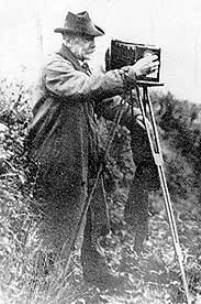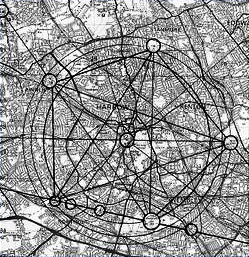When the Romans came to Britain, they found a land as mysterious and strange as darkest Africa was to the Victorians. Standing stones in the landscape, dreary and cold and with superstitious people who looked nothing like them, and had very odd religious practices. This was the land of the ghost story, of monsters and giants and of the Druids. The Romans discovered that stone circles, religious sites and burial grounds had a greater significance to the ancient Britons than they did for themselves. However, the Romans perhaps did not realise that these sites had an added purpose.
Although monuments and churches had ‘lined up’ in the landscape for centuries, it wasn’t until 1922 that Alfred Watkins put forward the concept of ‘ley lines’ to a modern audience. Whilst out on one of his many field trips Watkins, who was a keen archaeologist, photographer and geologist, noticed that many of the ancient monuments seemed to line up on the map. Subsequently to this epiphany he christened these lines ‘leys’ because of their intimate relationship to the lays – or pastures and valleys – which they traversed.
I had no theory when, out of what appeared to be a tangle, I got hold of the one right end of this string of facts, and found to my amazement that it unwound in an orderly fashion and complete logical sequence…I followed up the clue of sighting from the hilltop, unhampered by other theories, found it yielding astounding results in all districts, the straight lines to my amazement passing over and over again through the same class of objects…~ Alfred Watkins

After testing out the public response to his theory in his paper “Early British Trackways” (1922), Watkins wrote a book about the ley lines called “The Old Straight Track” and his opus purported that these old tracks were navigation lines used by ancient Britons to move around the island with confidence. The late Hamish Miller decided to prove this theory and in the 1970s he dowsed the St. Michael’s Line – the ley line from Cornwall to Suffolk. Miller later wrote about this experience in his book “The Sun And The Serpent.” Far from being dead straight, as per the popular perception of leys, the St. Michael’s Line is serpentine in shape.
Indeed, Watkins himself warns his readers in his introduction that his subject ‘is not that of Roman roads’. Other true ley lines are the Devil’s Arrows in North Yorkshire and the Dynedor Ley in Shropshire, although leys are traceable all over the UK and (a)cross the globe. That some buildings and ancient monuments in the landscape have remained unchanged for centuries would suggest that these holy sites have been reused over time.

In London, ley lines appear too. The Hampton Court Ley travels through Windsor, Staines, Ashford, Feltham, Hanworth, and Hampton and on to Hampton Court. This ley line has been dowsed by many local experts including Keith Hanson. Hanson is, like Hamish Miller, a well-respected dowser, who both trains others and gives demonstrations of his art. Watkins resisted applying a metaphysical interpretation to his study of leys, at least in academic circles. It was Hanson who postulated the theory that ley lines are rather special points on the earth: they appear to have a ‘positive’ and a ‘negative’ charge, much like a battery and at certain junctures (especially where positive and negative cross over each other) ghostly sightings and other paranormal experiences have been reported. This could be true; in 1988, a UFO was twice witnessed in Hampton by a local man who was returning from work one evening. The sightings were directly over the Hampton Court ley.

Highgate, once a part of old Middlesex and now encompassed into the urban sprawl of London, is just such a place where these ley lines interface. This is hardly surprising; in the 14th century, Swains Lane, an ancient drovers track which now divides the two halves of Highgate Cemetery, was an unpleasant and sloughy place, avoided by all but those who had no alternative route to Smithfields Market and home again. Latterly it became the haunt of cut-throats, and the epicentre of cholera outbreaks. This dark and foreboding reputation has continued through time into the present day. Sightings of ghosts and meetings with odd strangers in the lane still take place and in the 1960s, the cemetery was the haunt of a ‘tall, dark figure with red eyes’, which, thanks to local media, became a cause celebre. Many local people saw this figure but it wasn’t confined to the cemetery: sightings of it were reported in The Gatehouse and The Flask (two local pubs), council flats at Hillcrest and in Highgate Wood. Suspecting that the area was the site of at least one ley line, a group of investigators linked to The British Psychic and Occult Society decided to dowse the area in 2008. Not only did they discover two ley lines, but also discovered that both lines interfaced in Highgate Cemetery West. This revealed a lot about the phenomena haunting the place.
However, discovering that Highgate Cemetery West was at the intersection of two lines did not go far enough to explain the mysterious phenomena witnessed around the area. One of the investigators consulted a more knowledgeable source about the actions of ley lines. She was told that the electromagnetic force of a ley line can affect bodies when two cross over inside a burial ground. His theory stated that as the bodies decay over time, so does the aura and that at times, ghosts can be reported in the vicinity of said cemetery. This does not sound as incredible as one might think; some dogs have been drawn to their owners’ graves long after burial has occurred, presumably guided there by the auric emanation of the former owner. Given that reports of the ‘being’ that was seen inside and outside Highgate Cemetery sometimes indicate that it was ‘straggly’ and ‘unkempt’, this may suggest that the ‘being’ is casting off its earthly form. Witnesses also report that the figure resembles ‘an old fashioned undertaker’ and by this, one would gather that it is quite smartly dressed. This may be another entity, which is haunting the environs of Highgate Cemetery and may not necessarily be exclusive to Swains Lane: it might mean that Swains Lane is home to at least two black-clad figures.
Highgate Cemetery West was opened in 1839, receiving its first burial in May that year. It was once the gardens of the former Ashurst House, which stood on the site of present-day St. Michael’s Church. If the consultant dowser is correct in his assumptions then not all the bodies interred in the cemetery in its heyday have decomposed to the extent whereby their remains are merely skeletal. Given that Highgate Cemetery has catacombs, tombs, mausolea and vaults, this is probably right. Victorians buried the dead inside lead coffins if they were deposited inside a vault (this practice continues, but zinc is used nowadays) for health reasons; whilst those buried in the ground may well be decomposed to a skeleton, not all of the lead coffined bodies will be. Also, given that Highgate Cemetery West was subject to intense vandalism, satanic rituals and nature running riot during the 1960’s it may be possible that many bodies ‘resting’ there remain may have been collectively forced into an accelerated rate of decomposition at this time, as tree roots dislodged their coffins, and lead thieves and necromancers disturbed ‘the tranquility of the tomb’. Another more macabre explanation for the continued presence of this figure may be true. The Terrace Catacombs was built with two openings in its walls, quite low down to the ground. A guide informed a tour group that these openings served two purposes: to provide fresh air vents to the catacombs and to provide an escape route in case of premature burial.

Live burial was very much in the Victorian mind and more bizarre and unusual contraptions were invented in case this happened. Could someone have been buried before their time, perished inside their coffin and the ghost, activated by the ley line, haunts the cemetery? One can only speculate.
The cyclic occurrences of this figure, seen chiefly in Swains lane and elsewhere, may indicate that the ley lines spring into life at certain times. Looking at the dates of the reports, they seem to occur in approximately eleven year intervals. This ley line activity may be linked to the sunspot cycle of eleven years. Sightings of paranormal phenomena on other ley lines point to this being the a possibility.
The Hampstead Ley (as it has been called by investigators) continues to Fortune Green in the north east and across Parliament Hill to the south west. Parliament Hill is a very ancient site and has been the scene of reported ghostly phenomena over many years. It may be such phenomena, travelling across the ley line to Highgate, which was responsible for the dark reputation of Swains Lane many centuries ago. Fortune Green Cemetery has also been the location of at least one paranormal report. It may be that it takes more than ley lines to activate strange phenomena but it is consistent that such phenomena do arise where ley lines are present. Maybe our ancient ancestors knew all along that certain areas were special and that is why they built sacred monuments on such sites. It also seems likely to this author that not only were they right, but that we (sometimes inadvertently) continue with the practice even today.
We are more in touch with our ancient ancestors than we realise.
Further reading:
Watkins, Alfred. The Old Straight Track. London: Methuen Press; 1925.
Devereux, Paul. The New Ley Hunter’s Companion. London: Thames and Hudson; 1979.
Miller, Hamish and Broadhurst, Paul. The Sun and the Serpent. Pendragon Press, 1990.
Street, Christopher. London’s Leylines : Pathways of Enlightenment. Earthstars Publishing; 2010.
Langley, Patsy. The Highgate Vampire Casebook. London, British Psychic & Occult Society, 2010.
http://philipcarrgomm.wordpress.com/2008/01/28/alfred-watkins-the-old-straight-track-club/
Patsy Langley first became interested in Highgate and its cemeteries because of her interest in Pre-Raphaelite painters and poets. She has a degree in Earth Sciences and Humanities, and is an historian and a chartered accountant.
Patsy is a trained Spiritualist medium, and the Secretary of the British Psychic and Occult Society. She is currently working on an expanded and updated edition of her best selling 2007 book ‘The Highgate Vampire Casebook’, as well as a new book about haunted Middlesex. She has previously published many articles about ley lines and earth energies. Patsy is an active member of her local church choir and Royal British Legion




Thanks for this Patsy, much appreciated!